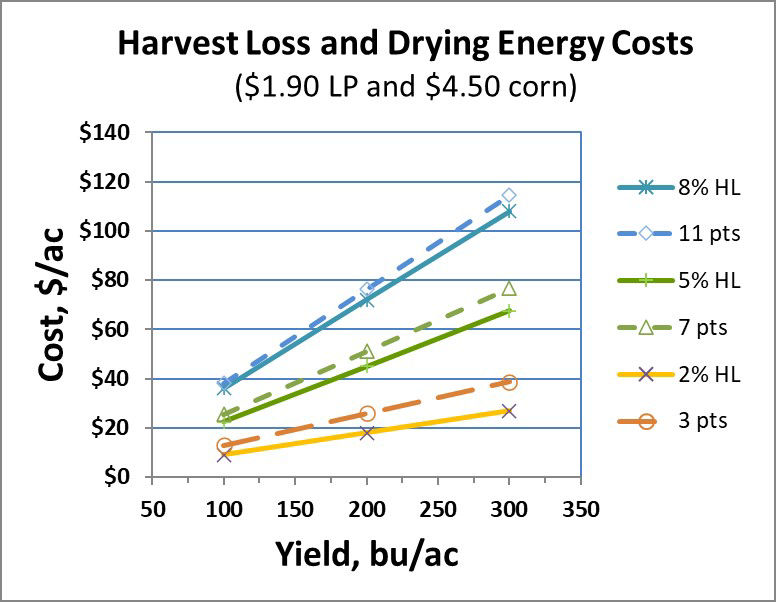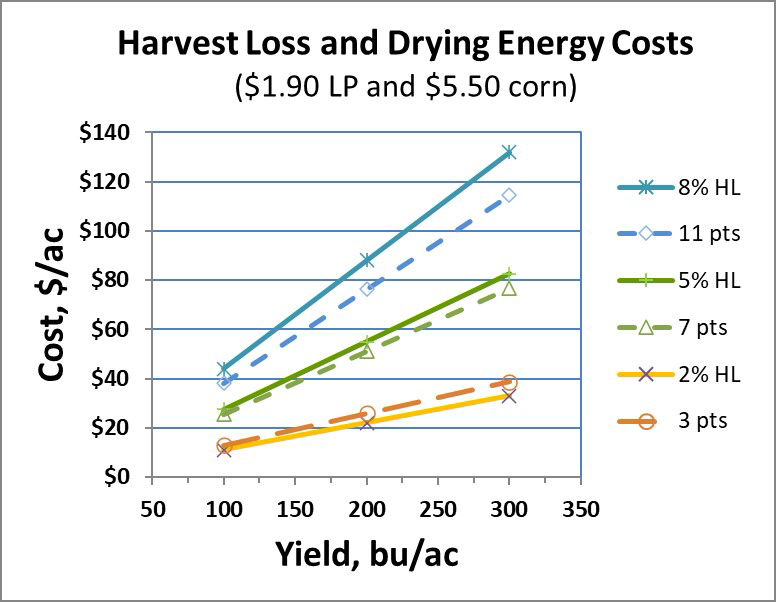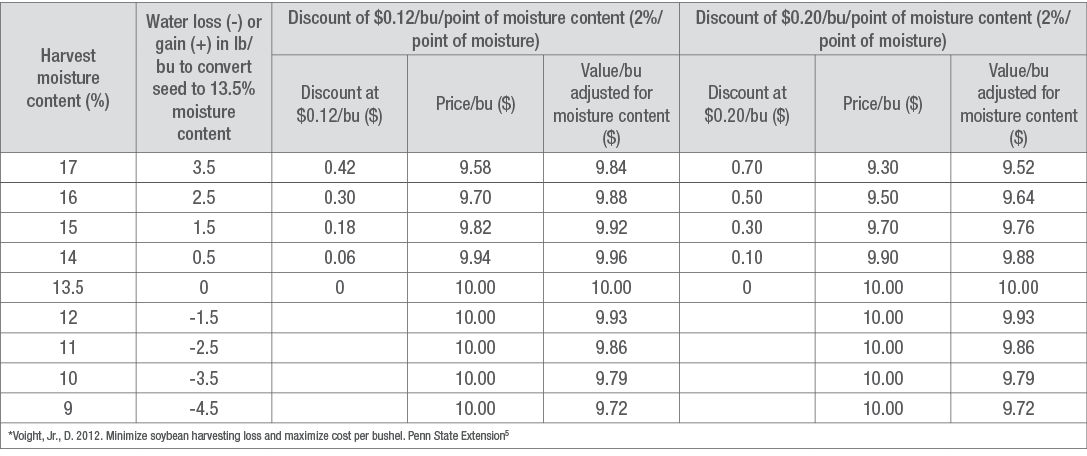3 MIN READ
Harvest Loss, Drying Costs, and Discounts
September 21, 2022
A timely harvest is critical to minimize corn and soybean harvest losses and help maximize profits.
Ear drop, open pods, lodging and grain that is too dry can result in lost yield potential.
Limiting harvest losses due to excessive field drydown can help compensate for expenses associated with grain drying and discount schedules.
Corn reaches physiological maturity, or black layer, when kernel moisture content is around 30%.1 The rate of grain drydown after maturity depends primarily on weather conditions after black layer but can also be affected by planting date, disease, and other factors. Late-planted corn or later-maturing corn products dry slower. Warm and dry weather speeds up the crop drying rate and wet and cool weather slows it down. Differences in ear and husk coverage among corn products can also affect drydown rates. Soybean field losses generally increase with delayed harvest because of shattering.
Corn Harvest Losses and Drying Costs
The optimum harvest moisture content for corn is about 23 to 25%. At this moisture content level, kernels shell easier and stalks are usually standing well, which helps make harvesting more efficient. With a timely and efficient harvest, losses should be minimized to around 1 to 2%. Delaying harvest until corn dries down to about 17 to 19% moisture content can save considerably on drying costs. However, as corn dries down in the field, there is a greater potential for excess harvest losses from stalk lodging and ear drop. Most harvest losses result from mechanical issues such as grain head shattering or plants never getting into the header. Allowing corn to dry in the field could lead to harvest losses of 2 to 8% above the normal levels of a timely and efficient harvest.2
Table 1 estimates the energy cost to dry corn and the value of excess harvest losses based on a yield of 200 bu/acre, corn price, and LP cost of $1.90/gallon. Estimates are provided for low (2% above normal), medium (5%), and high (8%) excess harvest loss conditions. When considering both harvest losses and drying costs, the table illustrates that harvesting at higher moisture content levels can be more profitable than allowing corn to remain in the field to dry, especially when medium to high excess harvest losses are expected. Table 1 is adapted from a spreadsheet developed by Dr. McNeill at the University of Kentucky. Farmers can access the spreadsheet to help determine returns for their operation by inputting their LP price and expected market price for corn. The spreadsheet can be accessed at https://www.uky.edu/bae/grain-and-energy-calculators.
Table 1. Estimated value of harvest losses and energy cost to dry corn with low, medium, and high excess harvest losses (Based on 200 bu/acre yield, corn prices of $4.50, $5.50, and $6.50/bu, and LP price of $1.90/gallon.**)

Figures 1, 2, and 3 show graphically how potential profitability relates to drying cost and harvest loss when harvest loss rates are 2%, 5%, and 8%, LP cost is $1.90/gallon, and market corn prices are $4.50, $5.50, and $6.50/bu. (Graphs created by Dr. McNeill, University of Kentucky and used with his permission).



Soybean Maturity, Harvest Loss, and Discounts
Timely soybean harvest is critical to help minimize field losses and help maximize seed weight. Harvest can generally start soon after seeds reach maturity and foliage is dry. Soybean seeds are mature when 95% of the pods are at their mature color.5 Planting dates and weather conditions play a big role in determining when plants are harvestable. Soybean seeds lose and regain moisture content more readily than other crops. Moisture content can increase with an overnight dew or rapidly decrease under dry and windy conditions.
The ideal soybean harvest moisture content is 13 to 15%. Threshing can be difficult and soybean seeds are more likely to be crushed and bruised when harvest moisture content is greater than 18%. At less than 13% moisture content, field losses from lodged plants and open pods tend to be greater and combine shatter losses can be as high as 10% of yield. When seeds reach less than 10% moisture content, seeds become brittle and are more likely to split during harvest. Cleaning and handling soybean seed at this moisture level can reduce germination.6 Rapid drydown and complications associated with harvesting green stems and pods are common reasons for harvesting at less-than-ideal moisture levels.
Studies show that 12% of the soybean crop can be lost during harvest.5 Average losses are around 5% with shattering losses accounting for 2% of total yield loss. Table 2 shows an example of soybean discount schedules for $10.00/bu. Soybean seeds testing over 13% moisture content are acceptable by the buyer as-is with the assumption that 60 lb of soybean seed is equal to one bushel. Although seeds greater than 13% moisture content are subject to a discount, this cost may be compensated by the reduction in harvest loss that comes from avoiding too much drydown in the field.
Table 2. Soybean discount schedule example at $10/bu and moisture weight/value for soybean seed other than 13.5% moisture content.*

It can be beneficial to start harvesting early to help minimize crop harvest losses. If you see lodging, open pods, or ear drop problems, harvest timing is critical to help maximize yield potential. Take the time to observe crop conditions in the field and balance field drydown with the potential for harvest losses.
Sources:
1Nielsen, R.L. 2011. Field drydown of mature corn grain. Purdue University. http://www.agry.purdue.edu/.
2McNeill, S.G. 2000. When should you start harvesting corn in 2000? University of Kentucky. http://www.ca.uky.edu/.
3McNeill, S.G. and Halich, G.S. Corn harvest losses vs drying costs. Biosystems & Agricultural Engineering, University of Kentucky. https://www.uky.edu/bae/grain-and-energy-calculators/.
4Edwards, W. 2014. Estimating the cost for drying corn. Ag Decision Maker. Iowa State University Extension and Outreach. https://www.extension.iastate.edu/agdm/crops/html/a2-31.html/.
5Voight, Jr., D. 2012. Minimize soybean harvesting loss and maximize cost per bushel. Penn State Extension. https://extension.psu.edu/minimize-soybean-harvesting-loss-and-maximize-cost-per-bushel/.
6Hurburgh, C.R., Jr. 2008. Soybean drying and storage. Pm-1636 (Revised from AE-3026, 1984, Misra, M.K. and Wilcke, W.F.). Iowa State University. https://dr.lib.iastate.edu/server/api/core/bitstreams/2e3ae05e-014b-495b-a73e-c0fc76cfaba5/content/.
7Dorn, T. 2009. Harvest soybeans at 13% moisture. University of Nebraska-Lincoln. https://cropwatch.unl.edu/harvest-soybeans-13-moisture/.
Websites verified 9/1/22.
1210_55582